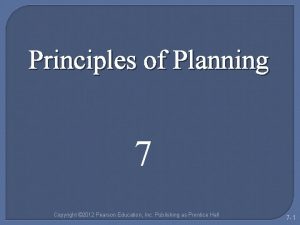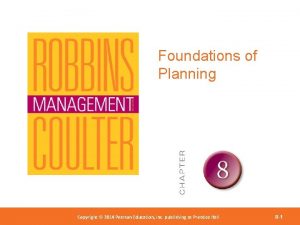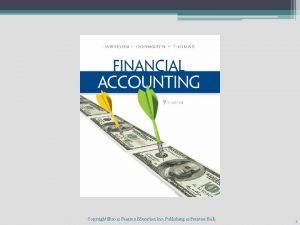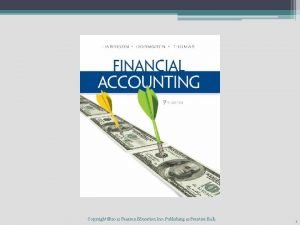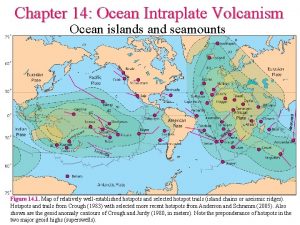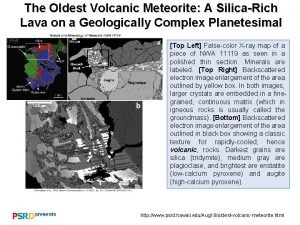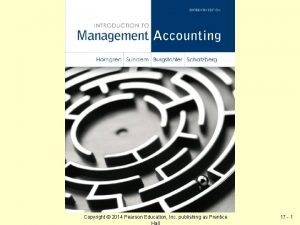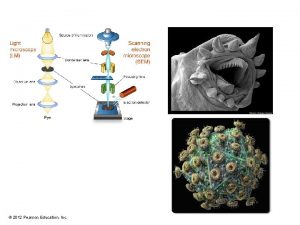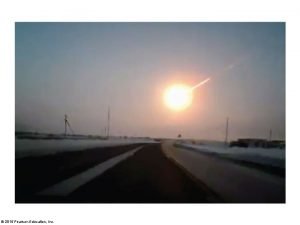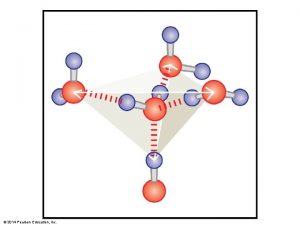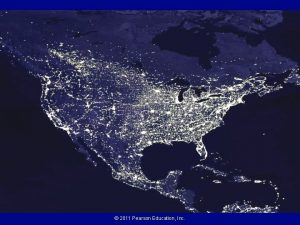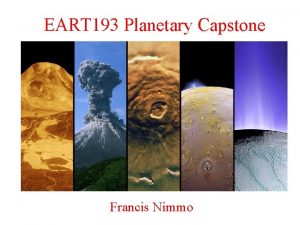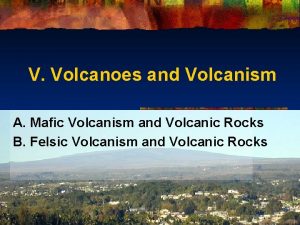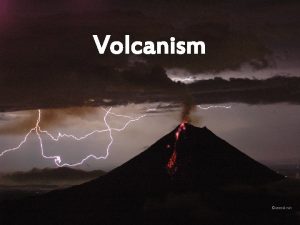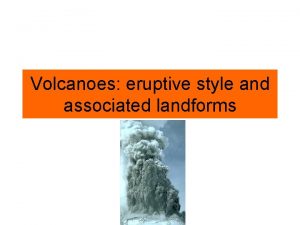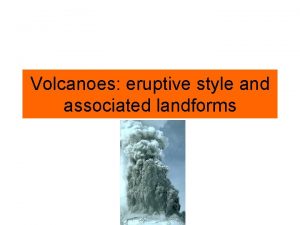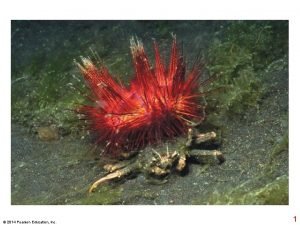Volcanism 2012 Pearson Education Inc Volcanism Eruptive Style









































- Slides: 41

Volcanism © 2012 Pearson Education, Inc.

Volcanism • • • Eruptive Style Volcanic Materials Volcanoes Other Volcanic Landforms Plate Tectonics and Igneous Activity © 2012 Pearson Education, Inc.

Eruptive Style Explosive Effusive © 2012 Pearson Education, Inc.

Eruptive Style • Why do volcanoes have different eruptive styles? – Pressure vs. resistance © 2012 Pearson Education, Inc.

Eruptive Style • A volcano is like a giant pop can that’s been shaken up – Pressure builds up – When pressure is released, material is pushed out © 2012 Pearson Education, Inc.

Eruptive Style • Pressure comes from gases dissolved in magma within the volcano – Mostly water vapor and carbon dioxide – When magma rises toward vent, gases come out of solution and expand © 2012 Pearson Education, Inc.

Eruptive Style • Resistance to this pressure comes from magma’s viscosity • Viscosity = resistance to flow (“thickness” or “stickiness”) • Higher viscosity = thicker, more resistant © 2012 Pearson Education, Inc.

Eruptive Style • Explosive eruptions – High-viscosity magma resists gas pressure • Effusive eruptions – Low-viscosity magma offers little resistance © 2012 Pearson Education, Inc.

Eruptive Style • Why are some magmas more viscous than others? – Temperature – Silica content • Silica = silicon and oxygen dissolved in magma © 2012 Pearson Education, Inc.

Eruptive Style • Why are some magmas more viscous than others? – Temperature • Hotter = less viscous (runnier) © 2012 Pearson Education, Inc.

Eruptive Style • Why are some magmas more viscous than others? – Silica content • More silica = more viscous (thicker) © 2012 Pearson Education, Inc.

Eruptive Style This volcano is fed by high-silica, low-temp magmas with high viscosity This one’s magma is low -silica and high-temp, and low viscosity © 2012 Pearson Education, Inc.

Eruptive Materials © 2012 Pearson Education, Inc.

Eruptive Materials • Lava Aa lava flow Pahoehoe lava flow © 2012 Pearson Education, Inc.

Eruptive Materials • Gases – Water vapor – Carbon dioxide – Smaller amounts of other gases © 2012 Pearson Education, Inc.

Eruptive Materials • Pyroclastics • • • Ash and dust – fine, glassy fragments Lapilli – walnut-sized material Cinders – pea-sized material Blocks – hardened or cooled lava Bombs – ejected as hot lava © 2012 Pearson Education, Inc.

Eruptive Materials • Pyroclastic flow – Hot, fast-moving cloud of pyroclastic material © 2012 Pearson Education, Inc.

Eruptive Materials • Lahar – Volcanic mudflow – Mixture of water, soil, and ash – Triggered by melting of snow during eruption © 2012 Pearson Education, Inc.

Eruptive Materials • Three Japanese lahars © 2012 Pearson Education, Inc.

Volcanoes © 2012 Pearson Education, Inc.

Volcanoes • Shield volcanoes – Largest type – Dome-shaped – Effusive eruptions – Much lava, few pyroclastics © 2012 Pearson Education, Inc.

Volcanoes Mauna Kea, a Hawaiian shield volcano © 2012 Pearson Education, Inc.

Volcanoes • Composite cones – Smaller than shield volcanoes – Classic “volcano shape” – Explosive eruptions – Much pyroclastic material, little lava © 2012 Pearson Education, Inc.

Volcanoes Mt. Fuji, a composite cone in Japan © 2012 Pearson Education, Inc.

A Composite Volcano Interbedded pyroclastic deposits and small lava flows © 2012 Pearson Education, Inc. Figure 4. 11

Volcanoes • Cinder cones – Smallest type – Loose pyroclastic materials © 2012 Pearson Education, Inc.

A Size Comparison of the Three Types of Volcanoes Figure 4. 14 © 2012 Pearson Education, Inc.

Other Volcanic Landforms © 2012 Pearson Education, Inc.

Other Volcanic Landforms • Calderas – Pits caused by magma chamber collapse – Three types • Hawaiian-type • Crater Lake-type • Yellowstone-type © 2012 Pearson Education, Inc.

Other Volcanic Landforms • Hawaiian-type calderas – On shield volcanoes Olympus Mons Kilauea © 2012 Pearson Education, Inc.

Other Volcanic Landforms • Crater Laketype calderas – Catastrophic eruptions © 2012 Pearson Education, Inc.

Other Volcanic Landforms • Yellowstone-type calderas – Largest © 2012 Pearson Education, Inc. Caldera outline (diameter approx. 30 mi)

Other Volcanic Landforms • Basalt plateaus – Very large, flat areas covered with basalt – Outpourings of low-viscosity lavas from fissure eruptions © 2012 Pearson Education, Inc.

Other Volcanic Landforms Fissure eruption in Hawaii Basalt plateau in Washington © 2012 Pearson Education, Inc.

Plate Tectonics & Igneous Activity © 2012 Pearson Education, Inc.

Plate Tectonics & Igneous Activity • Most volcanism occurs along tectonic plate boundaries – Divergent boundaries: decompression melting – Subduction zones: hydration melting © 2012 Pearson Education, Inc.

Plate Tectonics & Igneous Activity The “Ring of Fire” is a chain of active volcanoes around the Pacific Ocean. It marks the boundaries of tectonic plates. © 2012 Pearson Education, Inc.

Plate Tectonics & Igneous Activity • Hot spot (intraplate) volcanism – Not near plate boundaries – Fed by magma reservoirs beneath the crust © 2012 Pearson Education, Inc.

Plate Tectonics & Igneous Activity • Hawaiian Islands were formed by hot spot volcanism North Kauai 5. 1 my Oahu 3. 7 my Molokai 1. 9 my Maui 1. 3 my Hawaii (Big Island) < 1 million yrs old © 2012 Pearson Education, Inc.

Plate Tectonics & Igneous Activity • Hot spot animation © 2012 Pearson Education, Inc.

End of Chapter 6 © 2012 Pearson Education, Inc.
 Pearson education inc. publishing as prentice hall
Pearson education inc. publishing as prentice hall 2012 pearson education inc
2012 pearson education inc Pearson education inc. 2012
Pearson education inc. 2012 2012 pearson education inc
2012 pearson education inc Cephalic cranial
Cephalic cranial Pearson education inc. 2012
Pearson education inc. 2012 Pearson education inc. 2012
Pearson education inc. 2012 2012 pearson education inc anatomy and physiology
2012 pearson education inc anatomy and physiology 2012 pearson education inc
2012 pearson education inc 2012 pearson education inc
2012 pearson education inc Pearson education inc. 2012
Pearson education inc. 2012 2012 pearson education inc
2012 pearson education inc Pearson education inc. 2012
Pearson education inc. 2012 2012 pearson education inc
2012 pearson education inc 2012 pearson education inc
2012 pearson education inc Pearson education 2012
Pearson education 2012 2012 pearson education inc
2012 pearson education inc 2012 pearson education inc
2012 pearson education inc Prentice hall publishing
Prentice hall publishing Pearson education 2011
Pearson education 2011 Pearson education inc publishing as pearson prentice hall
Pearson education inc publishing as pearson prentice hall Pearson education inc publishing as pearson prentice hall
Pearson education inc publishing as pearson prentice hall Intraplate volcanism
Intraplate volcanism Meteorite
Meteorite Xantoame
Xantoame Classification de fredrickson
Classification de fredrickson Pearson education 2012
Pearson education 2012 2018 pearson education inc
2018 pearson education inc Copyright pearson education inc
Copyright pearson education inc Copyright pearson education inc
Copyright pearson education inc 2017 pearson education inc
2017 pearson education inc 2017 pearson education inc
2017 pearson education inc 2017 pearson education inc
2017 pearson education inc 2017 pearson education inc
2017 pearson education inc Pearson education inc 4
Pearson education inc 4 2015 pearson education inc
2015 pearson education inc 2014 pearson education inc
2014 pearson education inc 2013 pearson education inc
2013 pearson education inc 2013 pearson education inc
2013 pearson education inc 2013 pearson education inc
2013 pearson education inc 2013 pearson education inc
2013 pearson education inc 2010 pearson education inc
2010 pearson education inc






